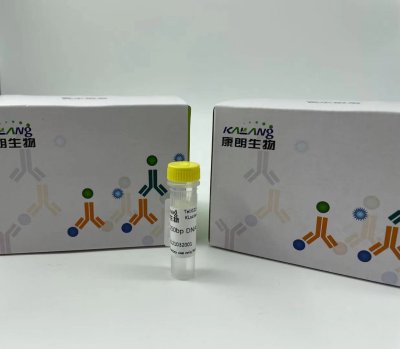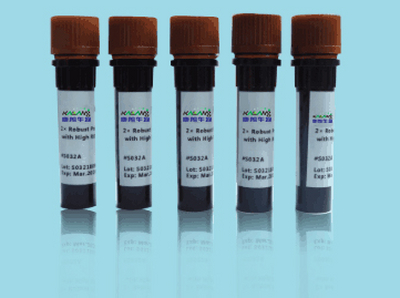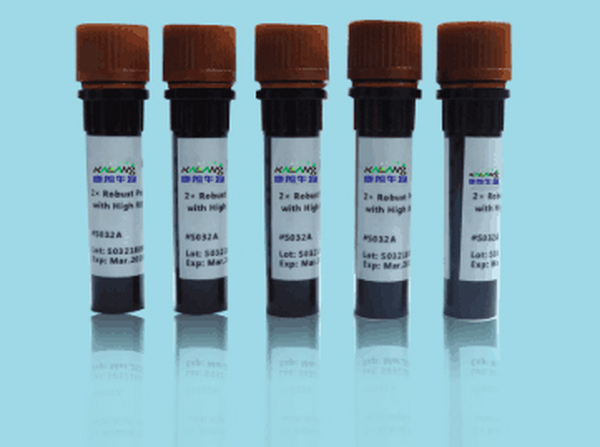QQ:3002763590


客服电话:021-61998208
DNJA2 rabbit Polyclonal Antibody
DNJA2抗体
DNJA2抗体应用:WB 1:500-2000 The protein encoded by this gene belongs to the evolutionarily conserved DNAJ/HSP40 family of proteins, which regulate molecular chaperone activity by stimulating ATPase activity. DNAJ proteins may have up to 3 distinct domains: a conserved 70-amino acid J domain, usually at the N terminus; a glycine/phenylalanine (G/F)-rich region; and a cysteine-rich domain containing 4 motifs resembling a zinc finger domain. The product of this gene works as a cochaperone of Hsp70s in protein folding and mitochondrial protein import in vitro. [provided by RefSeq, Jul 2008],
DNJB2 rabbit Polyclonal Antibody
DNJB2抗体
DNJB2抗体应用:WB 1:500-2000 ELISA 1:5000-20000DnaJ heat shock protein family (Hsp40) member B2(DNAJB2) Homo sapiens This gene is almost exclusively expressed in the brain, mainly in the neuronal layers. It encodes a protein that shows sequence similarity to bacterial DnaJ protein and the yeast homologs. In bacteria, this protein is implicated in protein folding and protein complex dissociation. Alternatively spliced transcript variants encoding different isoforms have been described for this gene. [provided by RefSeq, Jul 2011],
DNJB5 rabbit Polyclonal Antibody
DNJB5抗体
DNJB5抗体应用:WB 1:500-2000 ELISA 1:5000-20000DnaJ heat shock protein family (Hsp40) member B5(DNAJB5) Homo sapiens DNAJB5 belongs to the evolutionarily conserved DNAJ/HSP40 protein family. For background information on the DNAJ family, see MIM 608375.[supplied by OMIM, Mar 2008],
DNJB6 rabbit Polyclonal Antibody
DNJB6抗体
DNJB6抗体应用:WB 1:500-2000 ELISA 1:5000-20000DnaJ heat shock protein family (Hsp40) member B6(DNAJB6) Homo sapiens This gene encodes a member of the DNAJ protein family. DNAJ family members are characterized by a highly conserved amino acid stretch called the 'J-domain' and function as one of the two major classes of molecular chaperones involved in a wide range of cellular events, such as protein folding and oligomeric protein complex assembly. This family member may also play a role in polyglutamine aggregation in specific neurons. Alternative splicing of this gene results in multiple transcript variants; however, not all variants have been fully described. [provided by RefSeq, Jul 2008],
DNJC2 rabbit Polyclonal Antibody
DNJC2抗体
DNJC2抗体应用:WB 1:500-2000 ELISA 1:5000-20000DnaJ heat shock protein family (Hsp40) member C2(DNAJC2) Homo sapiens This gene is a member of the M-phase phosphoprotein (MPP) family. The gene encodes a phosphoprotein with a J domain and a Myb DNA-binding domain which localizes to both the nucleus and the cytosol. The protein is capable of forming a heterodimeric complex that associates with ribosomes, acting as a molecular chaperone for nascent polypeptide chains as they exit the ribosome. This protein was identified as a leukemia-associated antigen and expression of the gene is upregulated in leukemic blasts. Also, chromosomal aberrations involving this gene are associated with primary head and neck squamous cell tumors. This gene has a pseudogene on chromosome 6. Alternatively spliced variants which encode different protein isoforms have been described. [provided by RefSeq, Jul 2008],
DNJC3 rabbit Polyclonal Antibody
DNJC3抗体
DNJC3抗体应用:WB 1:500-2000 ELISA 1:5000-20000DnaJ heat shock protein family (Hsp40) member C3(DNAJC3) Homo sapiens This gene encodes a protein with multiple tetratricopeptide repeat (TPR) motifs as well as the highly conserved J domain found in DNAJ chaperone family members. It is a member of the tetratricopeptide repeat family of proteins and acts as an inhibitor of the interferon-induced, dsRNA-activated protein kinase (PKR). [provided by RefSeq, Jul 2010],
CYLC2 rabbit Polyclonal Antibody
CYLC2抗体
CYLC2抗体应用:WB 1:500-2000 ELISA 1:5000-20000cylicin 2(CYLC2) Homo sapiens Cylicin II (CYCL2) is specifically expressed in testis and is part of the cytoskeletal calyx of mammalian sperm heads. Cylicin II may play a role in the morphogenesis of the sperm head. [provided by RefSeq, Jul 2008],
CYLD rabbit Polyclonal Antibody
CYLD抗体
CYLD抗体应用:WB 1:500-2000 ELISA 1:5000-20000CYLD lysine 63 deubiquitinase(CYLD) Homo sapiens This gene is encodes a cytoplasmic protein with three cytoskeletal-associated protein-glycine-conserved (CAP-GLY) domains that functions as a deubiquitinating enzyme. Mutations in this gene have been associated with cylindromatosis, multiple familial trichoepithelioma, and Brooke-Spiegler syndrome. Alternate transcriptional splice variants, encoding different isoforms, have been characterized. [provided by RefSeq, Jul 2008],
CYR61 rabbit Polyclonal Antibody
CYR61抗体
CYR61抗体应用:WB 1:500-2000 ELISA 1:5000-20000cysteine rich angiogenic inducer 61(CYR61) Homo sapiens The secreted protein encoded by this gene is growth factor-inducible and promotes the adhesion of endothelial cells. The encoded protein interacts with several integrins and with heparan sulfate proteoglycan. This protein also plays a role in cell proliferation, differentiation, angiogenesis, apoptosis, and extracellular matrix formation. [provided by RefSeq, Sep 2011],
CYTD rabbit Polyclonal Antibody
CYTD抗体
CYTD抗体应用:WB 1:500-2000 ELISA 1:5000-20000cystatin D(CST5) Homo sapiens The cystatin superfamily encompasses proteins that contain multiple cystatin-like sequences. Some of the members are active cysteine protease inhibitors, while others have lost or perhaps never acquired this inhibitory activity. There are three inhibitory families in the superfamily, including the type 1 cystatins (stefins), type 2 cystatins and the kininogens. The type 2 cystatin proteins are a class of cysteine proteinase inhibitors found in a variety of human fluids and secretions. The cystatin locus on chromosome 20 contains the majority of the type 2 cystatin genes and pseudogenes. This gene is located in the cystatin locus and encodes a protein found in saliva and tears. The encoded protein may play a protective role against proteinases present in the oral cavity. [provided by RefSeq, Jul 2008],
最新动态
-

Anti-GNGT1 KL20092-001(50ul)
2021-10-11 -

Anti-GNGT1 antibody(50ul) KL20093-001
2021-10-11 -

MUC5AC (PT2058) mouse Monoclonal Antibody
2021-01-06 -

mOrange mouse Monoclonal Antibody(Mix)
2021-01-05
热门标签
- Histone H3 rabbit Polyclonal Antibody Histone H3抗体
- EGFR rabbit Polyclonal Antibody EGFR抗体
- Cy3 Conjugated
- AbFluor™ 555 Conjugated
- AbFluor™ 680 Conjugated
- AbFluor™ 350 Conjugated
- AbFluor™ 647 Conjugated
- AbFluor™ 594 Conjugated
- AbFluor™ 405 Conjugated
- Cy5 Conjugated
- AbFluor™ 488 Conjugated
- Cyclophilin B抗体 Cyclophilin B Monoclonal Antibody(2B10)
- COX IV抗体 COX IV Monoclonal Antibody(6C8)
- PCNA抗体 PCNA Monoclonal Antibody(12D10)
- FAK rabbit Polyclonal Antibody FAK抗体
邮箱:3002763590@qq.com
电话:021-61998208

扫码关注微信公众号






